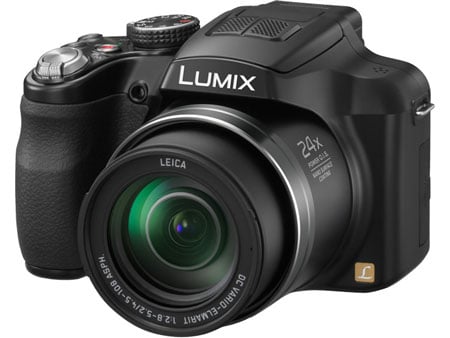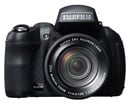Panasonic Lumix FZ60 / FZ62 review
-
-
Written by Ken McMahon
Verdict
The Panasonic Lumix FZ60 / FZ62 is one of two new super-zooms announced by the company in July 2012 and a more affordable version of the premium Lumix FZ200. It shares the more expensive model’s 24x zoom range and body, as well as many of its features, but the gap between these two models is widening.
While they share the same 25 – 600mm zoom, the FZ200 has a new constant f2.8 maximum aperture throughout the zoom range; the FZ60 / FZ62 retains the f2.8-5.2 maximum aperture of its predecessor, so at the maximum 600mm telephoto position it’s nearly two stops darker.
Previous models of Panasonic’s ‘second string’ super-zoom have been fitted with a CCD sensor, but the FZ60 / FZ62 is now equipped with a 16.1 Megapixel MOS sensor. This will raise eyebrows among those aware of Panasonic’s recent experience with high resoution CMOS sensors, and bucks a trend which has seen the company opt for lower resolution sensors in recent models. However, this new sensor delivers the excellent image quality that seemed to have eluded Panasonic in the past.
Along with the new MOS sensor come the handheld Night Shot and HDR stacking modes we’ve seen on similarly equipped models and faster continuous shooting, albeit in disappointingly brief bursts lasting a fraction of a second. The FZ60 / FZ62 reatains the 1080i/50/60 best quality video mode of its predecessor, along with the ability to manually control exposure and you can now manually focus the lens during video recording. Other improvements include an expanded range of Creative Control effects filters and new customisation options.
 |
Compared to Sony Cyber-shot HX200V
IThe Sony Cyber-shot HX200V has a 30x zoom range that outreaches the FZ60 / FZ62 at the telephoto end, but can’t match it’s 24mm equivalent super wide angle.
Both cameras offer a similar viewfinder experience, but the Cyber-shot’s LCD screen has a higher 921k resolution and is articulated. Also in its favour are the Cyber-shot HX200V’s continuous shooting modes, which offer the same 10fps full resolution speed, but for a longer 10-frame burst. Both cameras provide a range of effects filters as well as 3D shooting, but on the FZ60 / FZ62 you can put them to use while recording movies, which is not an option on the Cyber-shot HX200V. If you want to be able to shoot automatic panoramas, though, only the HX200V provides that option.
HX200V also provides superior movie modes with a best quality 1080p50/60 mode, with, like the FZ60 / FZ62, the option of AVCHD or MPEG-4 encoding. If you want control over exposure during moving shooting the FZ60 / FZ62 provides it, with access to the full range of PASM exposure modes, whereas with the HX200V you’re restricted to Intelligent Auto mode or a choice of scene modes.
At 18.2 Megapixels its CMOS sensor produces images that are a little larger than those from the FZ60 / FZ62, but lagged behind slightly in my quality and high ISO noise test results. Finally, the HX200V has a built-in GPS receiver that tags images with geopositional information – a useful feature for those looking for a camera to take on their travels.
With a bigger zoom, 1080p HD movies, better continuous shooting and GPS, the HX200V looks to be a winner, but it is a little more expensive than the FZ60 / FZ62 and it may be that none of those features a priority for you, in which case the FZ60 / FZ62 could prove a better value buy.
See my Sony Cyber-shot HX200V review for more details!
Compared to Fujifilm FinePix HS30 EXR
The Finepix HS30 EXR’s zoom range is 24 – 720mm, so will get you closer to the action and take in wider views than the 25-600mm equivalent range on the Lumix FZ60 / FZ62. The HS30 EXR’s zoom is manually operated, though, which you may or may not prefer to the FZ60 / FZ62’s two-speed motorised zoom.
The LCD screens on both cameras share the same 460k dot resolution, but the HS30 EXR’s screen is one of the best I’ve seen in terms of its performance outdoors in bright conditions and is articulated so can be flipped out for easy viewing at high and low angles. And it’s new 0.26in 920k dot EVF is bigger, brighter and more detailed than the FZ60 / FZ62’s.
The HS30 EXR has a hotshoe for an external flash and is equipped with a socket for an external mic which can also be used with a remote/intervalometer. Its best quality video mode is 1080p50/60 (region dependent) and it offers several reduced resolution slow motion modes, but it lacks the PASM exposure modes of the FZ60 / FZ62. Its continuous shooting performance is superior to the FZ60 / FZ62 with a full resolution 8-frame burst at 8fps.
In my outdoor quality tests the HS30 EXR fell short of the performance of the FZ60 / FZ62, but it does provide a RAW mode, something the FZ60 / FZ62 lacks. So if you like the idea of processing RAW files it’s possible you could improve on the in-camera JPEGS.
With a wider zoom range, better quality video, an articulated screen and high resolution EVF as well superior continuous shooting the HS30 EXR looks to be a compelling alternative to the FZ60 / FZ62 and it’s comparably priced. But it’s bigger and heavier and it’s manually operated zoom won’t suit everyone.
See my Fujifilm FinePIX HS30 EXR review for more details!
Panasonic Lumix FZ60 / FZ62 verdict
The Lumix FZ60 / FZ62 is an affordable version of Panasonic’s Flagship FZ200 superzoom, sharing the same 25-600mm zoom range, but with a differrent 16.1 Megapixel MOS sensor and lacking many of the premuim model’s features, most notably, an f2.8 maximum aperture that’s constant throughout the zoom range, high resolution electronic viewfinder, articulated LCD screen, RAW files, flash hotshoe and 1080p60/50 video.
That might sound like you’re missing out on a lot, but bear in mind the FZ60 / FZ62 is a little over half the price of its more capable sibling and it begins to look like an attractive deal. Then factor in a higher resolution MOS sensor which produces great quality images with excellent high ISO noise perfomance and it starts to look like a bargain. The FZ60 / FZ62 also includes many of the more expensive cameras features, such as Creative Control filter effects, 3D images, and stacking modes for improved low light performance.
In a Panasonic only World, that would be fine, but there’s strong competition from Sony, Fujifilm, Canon and Olympus in this market and, aside from the new sensor, I can’t help wondering if the FZ60 / FZ62 offers enough to make it attractive when the competion often has more to offer for a small price premium. And one other thing worth bearing in mind is that the FZ150 while still available will fall in price and look an increasingly attractive alternative.
There are a lot of pros and cons to weigh up, but when you’re done comparing all the specifications and weighing up the various pros and cons one thing stands out: in terms of the features it offers for the price, the FZ60 / FZ60 is currently one of the lowest cost, best value super-zooms on the market. That, combined with fact that it also produces great quality images and excels in low light earns it a Recommended rating.
Bad points | Scores (relative to 2012 super-zooms) |
 | ||
Build quality: Image quality: Handling: Specification: Value:
Overall: |
17 / 20 17 / 20 16 / 20 15 / 20 16 / 20
81% | |||






